Free August Fares Sought To Clear The Air, Lift Ridership, But Weekday Rides Jump Just 16% Due To Drug, Crime Worries
by Glen Richardson
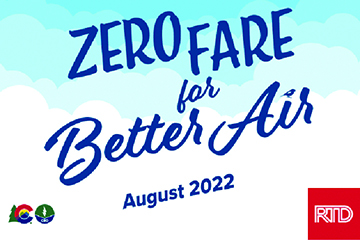 Reeling from the pandemic, changing work patterns, and lingering worker shortages, while grappling with drug use and crime, RTD is facing a ridership crisis that threatens to cripple or collapse the transit agency.
Reeling from the pandemic, changing work patterns, and lingering worker shortages, while grappling with drug use and crime, RTD is facing a ridership crisis that threatens to cripple or collapse the transit agency.
RTD’s month-long August “Zero Fare for Better Air” promotion drew only 16% more weekday boarders during the first week when “free” was expected to double ridership. The weekend — with live theatre, Broadway shows, and baseball — did double rides. The agency estimates it will lose $9.2 million in fare revenue during the month. The state approved an $8.7 million grant — Senate Bill 180 — for the fare free program. RTD is responsible for picking up the balance.
Whenever you say free, many contend, “It’s not free, someone is paying!” In RTD’s latest free foray, many expressed concerns that making it free would attract homeless riders, plus increase unruly behavior and criminal activity. Some said it was likely to attract drunk-disorderly riders. “It’s an awful idea and will chase away paying patrons, if it hasn’t so far,” others intimated.
Slow Start Scramble
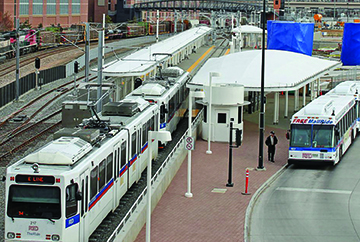
Crime Clogs Air Campaign: Drug, crime worries clogged RTD’s August Zero Fare for Better Air campaign as the transit agency’s buses, trains can’t find the combustion to attract commuters.
At the start of Zero Fare’s second week — safety and security issues were clearly crippling ridership. A series of outreach events with RTD Transit Police and Denver Police were quickly added. The four events — the first on Aug. 10 — were coffee chats designed to engage with potential customers and the community about security, service, and the Zero Fare incentive.
In March the agency hired Steve Martingano as RTD Police Chief. He has 22 officers to cover 2,300-sq.-miles. In June, RTD also approved a one-year contract extension with Allied Universal Security Services for up to $20.3 million.
RTD impact teams try to head off problems before customers board. Bus operators are asked if there are any problems on buses, seeking to ensure trips operate safely. At Union Station — where customers, employees, and visitors say they feel unsafe, and at least one business closed over crime — RTD is working with police, who have stepped up patrol. Denver Police made more than 800 arrests in and around Union Station in the six-months between November 2021 and April 30 of this year.
RTD’s System, Riders
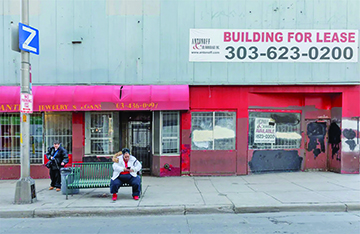
Bus Boondoggle: RTD’s bus network is adequate, but bus stops often aren’t more than a pole with a small sign. Sometimes there’s a lonely bench, but only 5% have shelters.
RTD’s metro service includes six light rail lines, two commuter rail lines, and 84 local-regional bus routes. There are more than 340,000 daily transit trips. Approximately 230,000 of the trips — or about two-thirds — are within Denver.
Annual ridership in 2021 included 6,585,500 commuter rail, and 10,016,300 light-rail riders. That compares to 4,954,167 on commuter rail in 2020, and 10,464, 678 on light rail. Bus boardings in 2021 were 31,598,000 compared to 32,932,000 in 2020.
In 2019 there were 9,711,377 commuter rail and 24,585,300 light rail boardings. Bus boardings in 2019 totaled 59,685,653.
Cars In Control
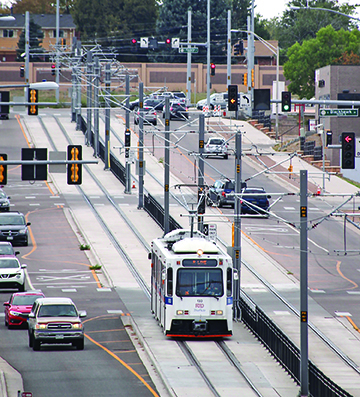
Cars Dominate Commute: Traffic on Valley highways and arterials at near-normal levels whereas RTD is still struggling to attract ridership for commuter trains and buses.
RTD hoped its Zero Fare for Better Air would attract customers by saving them money and reducing stress. It aimed to limit air pollution and ground-level ozone. The agency has added a 36 battery-electric sub-fleet on the 16th St. Mall and purchased an additional 17 zero-emission buses, as its better air commitment.
Nonetheless, RTD struggled despite free fare. Federal monitoring of traffic on the state’s highways-arterials, shows traffic at near-normal levels. Volume, at times, actually exceeds 2019 monthly totals. That’s true, even as the Valley’s weekday rush hours have changed.
Based on several studies, for Denver drivers to switch from their cars to riding buses and trains would require frequencies of every 15 minutes. That is far from the 30-minute standard here and in other cities.
Fab Hub Fades Fast
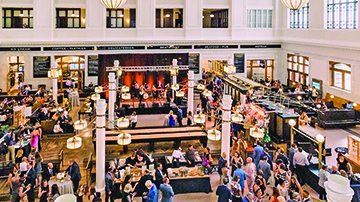
Fall Of Great Hall: Opening in 2014, Union Station’s Great Hall initially attracted 10 million people annually. Today it is depicted as a hotbed of violence and drug dealing.
Union Station — the $54 million renovation of the 1914 Beaux-Arts train station that opened in 2014 as RTD’s transit hub — was initially an amazing place. Located at 17th and Wynkoop, it included the historic, station house, a modern open-air train shed, and a 22-gate underground bus-light rail station.
It encompasses the Great Hall and Crawford Hotel plus dining-retail space. A popular weekend and holiday getaway spot for locals and travelers, it attracted more than 10 million people and featured dozens of free community events annually.
Eight years later it is depicted as a hotbed of violence and drug dealing. The Union Station neighborhood was consistently Denver’s 2021 second most crime-ridden neighborhood, according to Denver’s crime mapping. RTD has shut down bus terminal public restrooms and may corner-off a section of the terminal for those with paid fares.
X-Factor: Commuters
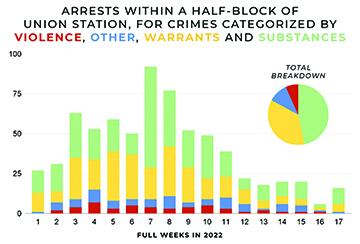 Even prior to the pandemic, RTD confronted several years of gradual and puzzling ridership drops. Ridership fell about 5% from 2014 to 2019, with a bigger 2019 bump.
Even prior to the pandemic, RTD confronted several years of gradual and puzzling ridership drops. Ridership fell about 5% from 2014 to 2019, with a bigger 2019 bump.
Ridership bottomed out at 30% of normal in the spring of 2020. Even as riders slowly return, recovery remains uneven. Buses attracted just 56% of the riders in November of last year as it did in the same month of 2019. Even with fewer trips, train ridership is performing at 37% to 48% of 2019.
The struggle to attract riders continues, with monthly data through last November indicating that about 53% of riders have returned.
Bus, Train Troubles
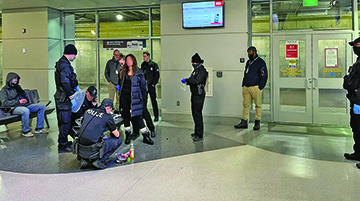
Crime Crisis: Not only did security worries cripple the better air campaign, RTD’s transit hub has been the scene of more than 1,200 arrests and tickets in the last six months.
Where RTD’s bus network has frequent service, it correlates well to population density. Service, however, is less reliable and stop amenities are lower quality. Thus, ridership lags despite buses going where people want to go. Meanwhile, RTD and Denver Police are literally trying to reclaim Union Station’s bus terminal. Planned security upgrades should help.
Denver’s light rail focuses on suburban-downtown trips. Service and amenities are decent, albeit stops often aren’t in useful spots and trains don’t show up on schedule.
A series titled “Ghost Train” is the focus of a CPR podcast miniseries that contends the ambitious, costly rail lines “have done relatively little to shift people around the region and is a story of disappointment and betrayal.”
